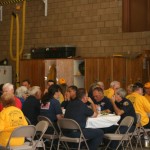Revival of a town siren was the main topic at last week’s Mountain Area Safety Taskforce. Public safety officials quickly sounded an alarm about the potential problem this heirloom might create for those unfamiliar with its intent.
Peter Lent, deputy director of the Riverside County Office of Emergency Services, introduced the topic at the request of Michael Feyder, Mountain Disaster Preparedness president.
“Our office, County Fire and the Sheriff’s [Department] do not support the emergency siren,” said Lent. “If it goes off, nobody knows what to do.”
Idyllwild Fire Chief Patrick Reitz had suggested it to Feyder. Their idea was that the siren — similar to alarms in other areas, such as the Midwest, for natural disasters such as tornados — would alert people of a fire danger. The blaring siren would signal people to go to Internet websites for official information and direction from OES, RC Fire or Idyllwild Fire, Feyder said.
“It would alert community and drive people to the sources of information such as the Town Crier, MDP’s Idyllwildemergency or WNKI,” Feyder suggested. “MDP would not be responsible for the siren. MDP would fund the education effort behind the system.”
Reitz stressed that several citizens had approached IFPD after the Mountain Fire to reactivate the siren and he added, “I’ve seen it work in other communities, but only with a lot of education.”
Neither described it as a solution or alternative to the county’s Early Warning Notification System, but they view it as another tool available in an emergency.
IFPD and MDP would test the alarm periodically throughout the year. They also promised an extensive information campaign in advance of the tests, so that residents would not confuse the test with an actual emergency.
Nevertheless, Riverside County Sheriff’’s and Fire departments, as well as Forest Service attendees, were skeptical of its benefit. While residents might be educated to respond properly to the warning, assuming they had and used Internet services, visitors and tourists would have minimal understanding of what was expected, said fire and sheriff staff.
Many officials expressed concern about the possibility of creating confusion and exacerbating the problems if a road closure were in effect. With only two routes out of town and three off the Hill, traffic flows could create problems and impede fire and emergency vehicles during a critical stage of these fires.
San Jacinto Ranger District Fire Chief Dan Felix reminded participants that this idea had been rejected about 10 years ago. “The nature of the community is week-enders and tourists who have no familiarity with the design of the evacuation plan.”
Rather than rely on a siren whose alert might not be understood by all who hear it, Riverside County Fire Chief John Hawkins recommended, “… getting WNKI involved in case of an emergency and the MDP’s citizen volunteers are a big part of the equation.”
IFPD and the Mile High Radio Club are nearing an agreement for MHRC to operate WNKI, according to Bill Tell, MHRC president. It was activated for last week’s emergency drill. Tell briefly discussed the possibility of extending its signal from Poppet Flat to Pinyon Pines.
According to long-time Hill resident Jerry Holldber, Pine Cove Water District general manager, the siren’s original purpose in the 1960s was to alert and activate IFPD’s paid-call unit of an incident, fire or traffic collision on the Hill.










